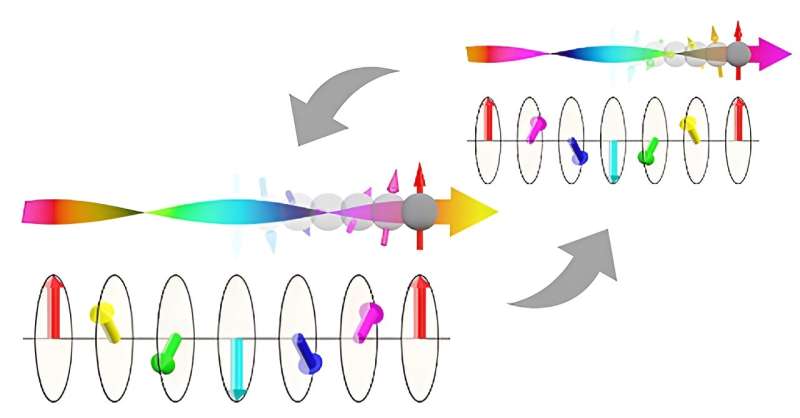This article has been reviewed according to Science X's editorial process and policies. Editors have highlighted the following attributes while ensuring the content's credibility:
fact-checked
peer-reviewed publication
trusted source
proofread
Downscaling storage devices: Magnetic memory based on the chirality of spiral magnets

A team of researchers has proposed a new concept for magnet-based memory devices that might revolutionize information storage devices due to their potential for large-scale integration, non-volatility, and high durability.
Details of their findings were published in the journal Nature Communications on March 7, 2024.
Spintronic devices, represented by magnetic random access memory (MRAM), utilize the magnetization direction of ferromagnetic materials to memorize information. Because of their non-volatility and low energy consumption, spintronic devices will likely play a pivotal role in future information storage components.
However, ferromagnet-based spintronics devices have a potential pitfall. Ferromagnets generate magnetic fields around them, which affect nearby ferromagnets. In an integrated magnetic device, this results in crosstalk between magnetic bits, which will limit the magnetic memory density.
The research team, which comprised Hidetoshi Masuda, Takeshi Seki, Yoshinori Onose and others from Tohoku University's Institute for Materials Research, and Jun-ichiro Ohe from Toho University, demonstrated that magnetic materials called helical magnets can be utilized for a magnetic memory device, which should resolve the magnetic field problem.
In helical magnets, the directions of the atomic magnetic moments are ordered in a spiral. The right- or left-handedness of the spiral, called chirality, could be utilized to memorize the information. The magnetic fields induced by each atomic magnetic moment cancel each other out, so the helical magnets do not generate any macroscopic magnetic field. "The memory devices based on the handedness of the helimagnets, free from the crosstalk among bits, could pave a new pathway for improving the memory density," says Masuda.
The research team demonstrated that the chirality memory can be written and read out at room temperature. They fabricated epitaxial thin films of a room-temperature helimagnet MnAu2 and demonstrated the switching of chirality (right- and left-handedness of the spiral) by the electric current pulses under magnetic fields. Furthermore, they fabricated a bilayer device composed of MnAu2 and Pt (platinum) and demonstrated that the chirality memory can be read out as a resistance change, even without magnetic fields.
"We have uncovered the potential capability of chirality memory in helical magnets for next-generation memory devices; it may offer high-density, non-volatile, and highly stable memory bits," adds Masuda. "This will hopefully lead to future storage devices with ultrahigh information density and high reliability."
More information: Hidetoshi Masuda et al, Room temperature chirality switching and detection in a helimagnetic MnAu₂ thin film, Nature Communications (2024). DOI: 10.1038/s41467-024-46326-4
Journal information: Nature Communications
Provided by Tohoku University





















